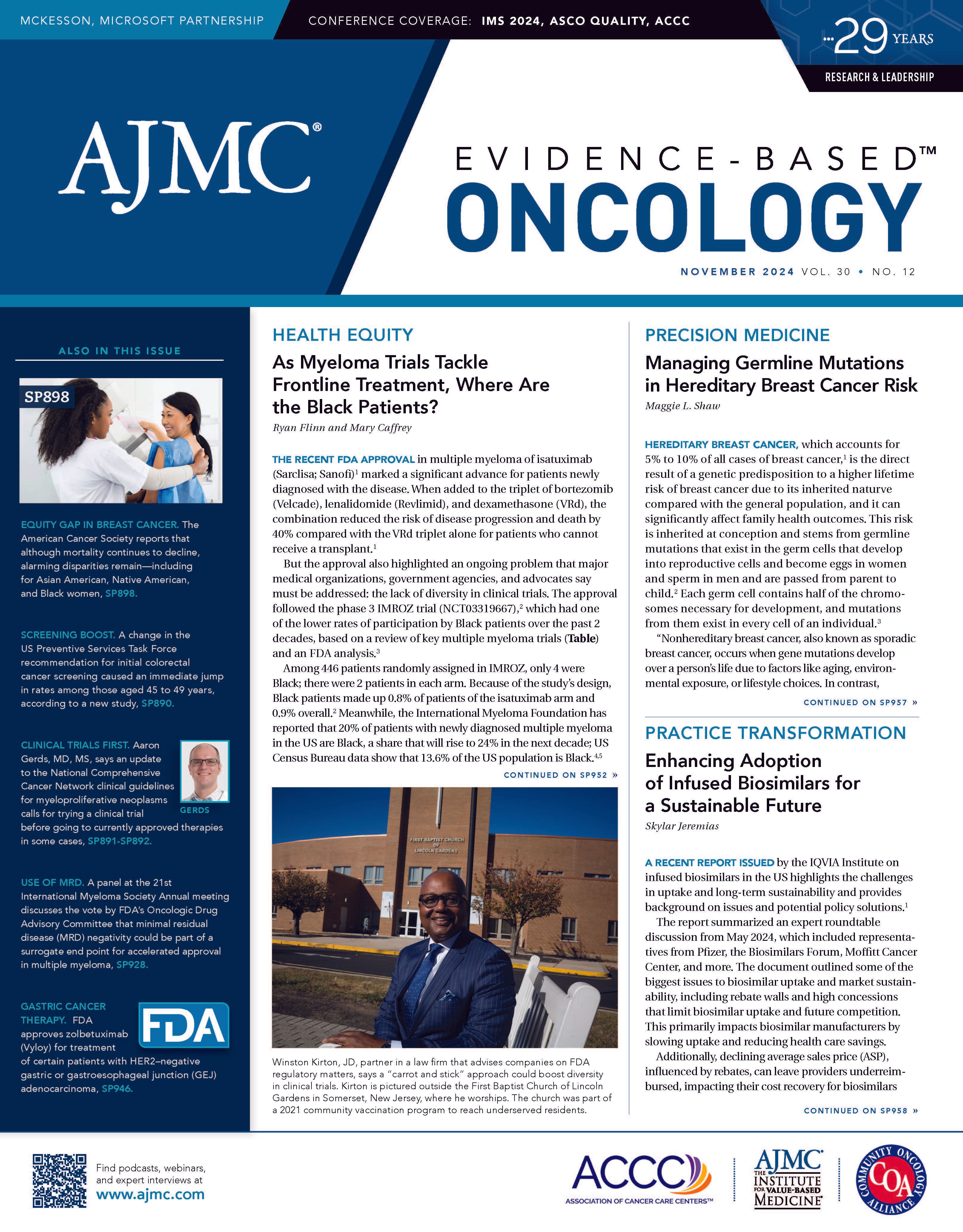- Center on Health Equity & Access
- Clinical
- Health Care Cost
- Health Care Delivery
- Insurance
- Policy
- Technology
- Value-Based Care
As Myeloma Trials Tackle Frontline Treatment, Where Are the Black Patients?
The recent FDA approval in multiple myeloma of isatuximab (Sarclisa; Sanofi) marked a significant advance for patients newly diagnosed with the disease. When added to the triplet of bortezomib (Velcade), lenalidomide (Revlimid), and dexamethasone (VRd), the combination reduced the risk of disease progression and death by 40% compared with the VRd triplet alone for patients who cannot receive a transplant.1
But the approval also highlighted an ongoing problem that major medical organizations, government agencies, and advocates say must be addressed: the lack of diversity in clinical trials. The approval followed the phase 3 IMROZ trial (NCT03319667),2 which had one of the lower rates of participation by Black patients over the past 2 decades, based on a review of key multiple myeloma trials (Table) and an FDA analysis.3
Among 446 patients randomly assigned in IMROZ, only 4 were Black; there were 2 patients in each arm. Because of the study’s design, Black patients made up 0.8% of patients of the isatuximab arm and 0.9% overall.2 Meanwhile, the International Myeloma Foundation has reported that 20% of patients with newly diagnosed multiple myeloma in the US are Black, a share that will rise to 24% in the next decade; US Census Bureau data show that 13.6% of the US population is Black.4,5
Surbhi Sidana, MD | Image credit: Stanford

“Multiple myeloma disproportionately impacts African American patients, and yet they’re underrepresented in clinical trials,” Surbhi Sidana, MD, associate professor of medicine at Stanford University in California, said in an interview. “This is a very well-established fact.”
Over the past 20 years, the uneven enrollment of Black patients in clinical trials has been a blemish on an otherwise glowing survival story in multiple myeloma. Since 2003, approvals for a dozen new drugs and multiple combinations have increased median survival from 3 to 10 years.6 The current frontier includes bringing the best therapies and quadruplet combinations to frontline treatment, reaching approximately 35,780 people who will receive a multiple myeloma diagnosis in 2024.7 In the US, the Black population will be impacted at a rate 2- to 3-fold higher than the White population, according to the American Cancer Society.7
IMROZ is hardly an outlier, however. As new waves of treatments, including cell and gene therapies, push for frontline treatment status, many are being studied in far more restricted, limited means than earlier generations of biologic and small molecule medicines.
For instance, there is the PERSEUS trial (NCT03710603), which evaluated subcutaneous daratumumab (Darzalex; Johnson & Johnson) with and without the VRd triplet in patients with newly diagnosed, transplant-ineligible multiple myeloma. Black patients were underrepresented (9 of 709 participants), a statistic the trial authors acknowledged in The New England Journal of Medicine (NEJM).8
At the 2024 International Myeloma Society Annual Meeting and Exposition in September, investigators for another phase 3 study in patients with newly diagnosed multiple myeloma, CEPHEUS (NCT04751877), did not report any race-related results during the readout,9 even when someone inquired about these data during the session. The lead investigator of CEPHEUS, which is evaluating subcutaneous daratumumab with and without the VRd backbone in patients for whom a transplant is not planned, said characteristics of the 395 patients would be reported later.9
FDA Acts on a Lingering Disparity
Lack of trial diversity in multiple myeloma persists, despite criticism that started well before the COVID-19 pandemic, when ProPublica and STAT reported that only 13 Black patients, or 1.8%, were among the 722 participants in a trial that led to the 2015 FDA approval of ixazomib (Ninlaro; Takeda).10 Then, in 2017, FDA officials wrote in the journal Blood how Black patients may experience multiple myeloma symptoms, disease progression, and treatment responses differently than White patients, acknowledging that “higher enrollment of Black subjects in clinical trials would have multiple benefits.”3
The FDA authors calculated that in the 21 applications submitted between 2003 and 2017 for multiple myeloma indications, 20 of the 23 pivotal trials included data by race. Enrollment of Black participants ranged widely, from 0.5% to 19.9% of the trial population. The median percentage of Black patients enrolled was 4.5%.3
FDA’s analysis in Blood, the official journal of the American Society of Hematology (ASH), appeared on December 7, 2017, timed to capture attention during the ASH Annual Meeting and Exposition. According to the record on clinicaltrials.gov, the IMROZ trial started the same day.11
Why trials matter. Clinical trial participation is considered at least not detrimental to survival, and in some types of cancer, it is superior to available treatments.12,13 Although the survival gap between Black and White patients with cancer has narrowed over a generation, increased trial participation is one strategy for closing it further. Since 2000, the overall cancer mortality rate ratio between Black and White individuals has dropped from 1.26 (95% CI, 1.25-1.27) to 1.12 (95% CI, 1.11-1.13) in 2020, with a corresponding decrease in absolute rate differences (51.99-17.54 per 100,000 population).14
Joseph Mikhael, MD | Image: International Myeloma Foundation

“The idea of ensuring that there’s appropriate representation of clinical trials is really a fundamental importance, because the essence of doing a clinical trial is to demonstrate that an intervention is safe and effective in the population that will ultimately receive the drug,” said Joseph Mikhael, MD, who is a professor in the Applied Cancer Research and Drug Discovery Division at the Translational Genomics Institute; Mikhael is also chief medical officer for the International Multiple Myeloma Foundation. “I want to make sure when I have a conversation with a patient that I know that this drug is both safe and effective.”
Today in the US, 4.4% of Black individuals with cancer participate in clinical trials compared with 7.2% of White individuals.15 Improving diversity is crucial for understanding how treatments affect different populations and for improving overall patient outcomes. Now the FDA is prepared to move forward with new guidelines spelling out requirements for “diversity action plans” that drug developers must submit before starting pivotal trials. On June 26, 2024, the FDA released the draft guidance,16 which states that sponsors must include enrollment goals and strategies to reach targets in their plans, such as selecting accessible trial sites and community engagement.
“Participants in clinical trials should be representative of the patients who will use the medical products,” Robert M. Califf, MD, FDA commissioner, said in a statement. “The agency’s draft guidance is an important step—and one of many ongoing efforts—to address the participation of underrepresented populations in clinical trials to help improve the data we have about patients who will use the medical products if approved.”17
A Pandemic Brings Lack of Equity Into Focus
Winston Kirton, JD, is a partner in a law firm that advises clients on FDA regulatory issues. He is pictured in front of First Baptist Church of Lincoln Gardens in Somerset, New Jersey, where he worships; the church has collaborated with state health officials on vaccine programs for underserved residents. | Image credit: Photo courtesy of Winston Kirton

Few things in science have remained as steady as the low participation rate in clinical trials. In 1993, the National Institutes of Health issued a mandate requiring the inclusion of women and minority individuals in clinical trials,18 but disparities continued. The American Society of Clinical Oncology (ASCO) had been at work on policies to address gaps in clinical trials and the workforce when the COVID-19 pandemic brought widespread attention to the need for greater health equity. Today, the topic appears on the agenda at major medical meetings, and drug manufacturers, government agencies, and industry groups advocate for diversity, equity, and inclusion (DEI) in medical research.
ASCO has since published an action plan19 with a goal to “infuse equity into everything we do at ASCO.” ASH offers a tool kit20 for trial sponsors who want to incorporate DEI principles. Additionally, the National Comprehensive Cancer Network has formed an alliance with the American Cancer Society Cancer Action Network to “promote meaningful systems change,” through advocacy and education initiatives.
Yet, the situation may become worse before it improves. Novel classes of therapies that have shown the greatest promise in helping patients with cancer, such as immunotherapies or cell and gene therapies, often come with strict eligibility criteria and are primarily administrated at major academic medical centers, adding barriers to access.
The issue is an acute one for multiple myeloma, as it is among the cancers that disproportionately impact the Black population. Yet since the emergence of current therapies for the disease, there has been inconsistency across trials, both in enrolling Black patients and when it comes to reporting data in leading journals.
For example, despite the complexity of the therapy, the CARTITUDE-1 trial (NCT03548207) for Janssen’s chimeric antigen receptor (CAR) T-cell therapy, ciltacabtagene autoleucel (Carvykti), which was approved in 2022,21 had a comparatively high level of participation by Black patients at 17.5% (Table). In the phase 2 trial (NCT00511238) that led to the first indication for carfilzomib (Kyprolis; Amgen) in 2013, 19.9% of participants were Black.22
In the phase 2 DREAMM-2 trial (NCT03525678) of belantamab mafodotin (Blenrep; GSK), 13.5% of participants were Black. The drug originally received accelerated approval in 2020,23 although it was later taken off the US market.
But lower rates of participation were seen in the trial for ixazomib (NCT01564537),24 along with Celgene Corporation’s pomalidomide (Pomalyst), which was approved in 2013 with a participation rate of 1.5%25 for Black patients (NCT01311687).
Location could be a factor in these participation rates; Celgene officials noted that it had just 1 trial site in the US, where the Black population is larger, with the remaining 92 sites divided across Europe (68), Australia (10), Canada (10), and Russia (4). The same trend appeared in Celgene’s idecabtagene vicleucel (Abecma) clinical trial (NCT03651128). The CAR T-cell therapy, which was approved by the FDA in 2021, had 9.3% Black participants in its phase 3 trial, a share that increases to 18% when isolating the 19 US trial sites.26
Trial site location was also a factor for Sanofi’s IMROZ trial. This study enrolled most of its patients (62%) in Europe, with little participation from North America (1.8%). The global study included sites in Asia, Australia, New Zealand, Russia, and Turkey. Although the overall Black participation was low, at the trial’s single US site, the rate was 25%.
“Sanofi recognizes that diversity in clinical trials is a global, multidimensional challenge, and we are deeply engaged in ensuring that our studies reflect the diversity of patients we aim to treat. We are committed to designing our clinical trials to be inclusive and more representative of the populations most likely to benefit from our medicines,” a company spokesperson said in an emailed statement.
Mikhael said when large studies like IMROZ start out with only 2% to 4% of the patients based in the United States, it’s hard to meet metrics that represent the US population. “As you know, race and ethnicity are captured differently in Europe. There is ongoing work to try to capture this more effectively. But I think as we do that, here in the US, it’s going to be fundamental that the FDA starts to say, ‘Why did you run a trial in the United States, and you didn’t have even at least have 10% of the patients who were African American?’” given that 20% of newly diagnosed multiple myeloma patients are Black.
He added, “I’m encouraged by the fact that some of the larger US-based trials, like the DETERMINATION study (NCT01208662), that was recently published looking at upfront transplant versus delayed transplant, had 19% representation of African Americans.”27
Multiple Strategies to Diversify Enrollment
A range of clinicians, advocates, and experts who were interviewed say that a multipronged approach involving greater community outreach, physician education, and incentives are needed to address longstanding disparities. Sidana, who has been involved with several CAR T clinical trials, said location is a key factor, noting that only one-third of Black residents in the US live in a county where a CAR T trial is being held for multiple myeloma. Mikhael concurs.
“Do patients even live near a center that’s offering those trials?” Sidana said. “We know from prior studies that there might have been some mistrust of the system due to historical issues. However, we know that when we offer minorities participation in clinical trials, most of them will say, ‘yes.’”
Achieving equitable participation in clinical trials is possible. Sidana pointed to research conducted by Luciano Costa, MD, PhD, of the University of Alabama at Birmingham, that was able to recruit 20% Black participants.28 Called MASTER (NCT03224507), the single-arm, phase 2 study, which tested daratumumab, carfilzomib, lenalidomide, and dexamethasone in patients with newly diagnosed multiple myeloma, earned a round of applause for its diverse patient group when the initial results were presented at the 2019 ASH Annual Meeting and Exposition.29
Inconsistent reporting. The fact that IMROZ and PERSEUS both reported racial participation data in journal articles could be seen as progress. As with enrollment itself, reporting of enrollment by race in leading journals has evolved over time. In 2003, the original NEJM article that reported the phase 2 results on the breakthrough proteasome inhibitor bortezomib did not mention the study population’s racial or ethnic makeup; the trial investigators reported in Blood in 2005 that 11% of the patients were Black.30,31 Over the past decade, presentation of participation data has been inconsistent, even when the enrollment of Black patients is relatively robust. A year after MASTER made news, results for GRIFFIN (NCT02874742), which examined daratumumab with VRd in transplant-eligible newly diagnosed multiple myeloma, did not mention enrollment data by race in Blood.32 However, an in-depth analysis comparing results by race appeared in 2024, showing that 15.5% of the 207 randomly assigned patients were Black.33 Although progression-free survival (PFS) rates for the Black patients did not match those of the White patients, results showed PFS exceeded that of the control arm; however, Black patients were more likely to stop at least 1 drug due to adverse effects.33
In some cases, racial or geographic groupings have obscured small numbers of Black patients. For example, the 2020 phase 3 CANDOR trial (NCT03158688) compared carfilzomib, dexamethasone, and daratumumab with carfilzomib and dexamethasone in patients with relapsed or refractory multiple myeloma; it took place largely in Europe and the Asia-Pacific region. In The Lancet, CANDOR reported 366 patients as White, 66 patients as Asian, and 34 as other/unknown.34 However, on the FDA website clinicaltrials.gov, the last category is broken out to show that only 9 patients in the study were Black (1.9%).35
Since the COVID-19 pandemic, racial participation data might not be available when a trial is presented at a conference, but breakdowns are eventually posted for completed trials. The FDA now prepares “drug trial snapshots” with newly approved therapies that include these data. Since the pandemic, authors who publish results from a plenary session in NEJM have typically included enrollment by race with baseline data.
Education matters. Lori Pierce, MD, FASTRO, FASCO, a former ASCO president and chair of its Equity, Diversity, and Inclusion Committee, pointed out the need to better educate physicians on asking their patients whether they would be interested in participating in clinical trials.
Lori Pierce, MD, FASTRO, FASCO | Image: ASCO

“One of the biggest barriers is that these patients are not even offered a clinical trial as a treatment option, due to assumptions about willingness and ability to participate,” she said. “There isn’t a set routine or script for practitioners to ask every patient with cancer whether they’d like to participate in clinical trials.”
Research bears this out: A 2021 study36 by the National Cancer Institute found that when offered the opportunity to participate in clinical trials, Black and White patients participate at similar rates (58% and 55%, respectively).
However, a survey reported at ASCO in 2022 found that 40% of Black patients with metastatic breast cancer said their doctor never told them about the possibility of a clinical trial.37 With this in mind, ASCO and the Association of Cancer Care Centers launched the Just Ask initiative, which trains frontline oncologists on how to discuss clinical trial participation with their patients.38
Another reason for the racial disparity is the exclusion criteria used to determine who can and who can’t participate in a clinical trial. In the American Association for Cancer Research’s 2024 Cancer Disparities Progress Report, the authors cited data from the FDA that ineligibility rates in multiple myeloma clinical trials were higher for Black patients (24%) compared with White patients (17%), even though both prevalence and mortality are highest among the Black population in the US.39
Barriers from the patient side include mistrust of medical research, which remains due to historical harm to Black individuals, such as forced sterilization practices,40 the Tuskegee study,41 and the development of the Henrietta Lacks immortal cell line.42
Shakira J. Grant, MBBS, MSCR, a principal investigator and geriatric hematologist-oncologist, published a study43 earlier this year examining awareness of these historical practices and modern beliefs among current Black and White patients with multiple myeloma. She found both reluctance toward new treatments and a sense that Black patients don’t receive the same care and attention that White patients do. “I don’t want to be a guinea pig,” one Black patient said in the study. “I’m not afraid of science if used properly, but if it’s [going to] be misused, you will not misuse it on me if I can help it.”
“This study revealed that [although] medical mistrust is often linked to historical events, many patients and their families still encounter experiences within today’s health care system that fuel ongoing mistrust,” Grant said.
Winston Kirton, a partner at law firm BakerHostetler who advises companies on FDA regulatory matters, believes in a “carrot and stick” approach to increasing diversity in clinical trials. The FDA’s diversity action plan guidelines are a good step, but without “teeth,” they may be ineffective. “You can mandate these things, but you’re going to get challenges and arguably stave off some level of innovation,” Kirton said. “Maybe there are opportunities for incentives: Can you incentivize a smaller company with some tax credits? Can you give expedited reviews? Can you give fee waivers? Can you grant extended exclusivity?”
Kirton advocates for more collaboration among patients, government agencies, nonprofits and drug companies—examples of which were seen during the pandemic. He described how his church, the First Baptist Church of Lincoln Gardens in Somerset, New Jersey, was part of a 2021 state-sponsored community vaccination program to provide equitable access to underserved residents.44 The church was able to provide vaccinations to thousands of individuals in the community, not just Black parishioners.
“You have to find people in the community [who] are trusted, people in the community [who] are looked up to, [and] people in the community [who] are not self-interested in the process to be able to deliver the truth and set examples,” Kirton said.
New technology and digital tools such as artificial intelligence (AI) may be able to help drug companies better identify potential clinical trial sites that can help increase diversity and inclusion rates. However, more work needs to be done to build relationships with these communities before the trial starts or even before someone receives a diagnosis, said Tiffany Whitlow, cofounder and chief development officer of Acclinate, a digital health company focused on improving health equity.
“There will never been an AI that does better than a person asking you, ‘How are you feeling today?’” Whitlow said. Her company specializes in data analytics and patient outreach, working with community leaders to both bring awareness and generate participation in medical research.
We educate patients of color, but clinical trials are just one aspect of that. We engage people before they get sick,” she said. Identifying the right leaders who have the ear of their community is critical, according to Whitlow. “They want to hear from people who are not incentivized by medical providers. We have had a lot of luck working with [Historically Black Colleges and Universities], faith leaders, [and] even little league coaches.”
Whitlow also called out ancillary costs that can hinder clinical trial participation for people in lower socioeconomic groups, such as travel costs to sites or requiring frequent follow-up visits during working hours. Travel reimbursement and flexible scheduling could help alleviate these issues, she said.
Mikhael agreed on the need for a multipronged strategy, and he has taken part in these efforts. “I do a lot of these church events, fraternity, sororities, community centers, where you don’t just wait until the patient gets sick and comes to us. The concept of community engagement, that to me is trust,” he said.
“It requires carrots and sticks,” he continued. “If you’re just doing this because it’s being mandated if it’s just the stick as it were then then it’s not going to be as successful.”
Despite the challenges, there have been some successful strategies to improve diversity in medical research. Liz Beatty spent 15 years running clinical trials at Bristol Myers Squibb before cofounding Inato, a company that helps connect clinical trial sponsors with research sites. Although trial sponsors typically reach out to sites to participate, Inato flips the dynamic by working with more than 4500 sites worldwide to provide them with the resources and industry connections to offer their patients (many in diverse communities) access to trials.
"We have to go to where the patient is and build a new ecosystem of research where trust is at the forefront of what we do,” Beatty said. By taking this approach, Inato was able to help Moderna, Inc, recruit patients for vaccine trials, where 62% of enrollees were from diverse backgrounds.
One of the challenges with newer treatments, such as cell and gene therapies, is that complex administration procedures and strict safety guidelines often mean only large academic research centers can offer them. “That’s not where people are receiving care, especially for underrepresented populations. It’s not where they’re accessing health care at all,” Beatty said. “If we really want to have representative data, we’re going to need to make investments to actually change access for sites for these more complex therapies, make sure they have the right training, [and] make sure they’re ready for these trials.”
A key will be how the FDA follows through on its commitment to demanding more diverse trial populations. During a podcast in May 2023, FDA’s
Atasi Poddar, PhD | Image: FDA

a health science policy analyst in the Office of Medical Policy at the Center for Drug Evaluation and Research, said sponsors must ensure that trial participants “match the patients who will take the drug” in this country.
“As we know, the United States is a melting pot, with people of different races and ethnicities. [The] FDA recommends that sponsors include underrepresented racial and ethnic populations, such as Black people, Asian people, people of Hispanic heritage, and Native American people or Pacific Islanders in trials to identify how a variety of people will respond to the new drug,” she said. “Studying the drug in different people leads to a better understanding of the drug, which is helpful to everyone.”45
However, at an industry forum a year later, some said nothing will change until the FDA holds up an application over the failure to enroll a diverse study group.46
Ian Flinn MD, PhD, is actively pushing for greater community health center participation. Flinn is the chief scientific officer at 2 organizations: Tennessee Oncology, one of the country’s largest community-based cancer care specialists, and OneOncology, a physician-led national platform for independent oncology practices. Through these roles, he has been able to partner with drug manufacturers to expand access to patients who live outside of major city centers.
“We think our model of being in the community—not just in certain large centers—by definition, brings a more diverse patient population,” Flinn said. “Every time we have a meeting with a sponsor, they always want to know what we are doing to increase diversity, but I’ll [point] the question back to them: What are you doing about it?”
It’s a theme that he intends to continue sharing with drug manufacturers that want to work with his organizations for clinical trials. “One of the messages I’m going to give them is: If you’re interested in increasing [DEI], let us use all our locations, not just the central ones.”
Editor’s Note: Ian Flinn, MD, PhD, is not related to the author, Ryan Flinn.
References
1. Sarclisa approved in the US as the first anti-CD38 therapy in combination with standard-of-care treatment for adult patients with newly diagnosed multiple myeloma not eligible for transplant. Press release. Sanofi; September 20, 2024. Accessed October 30, 2024. https://www.sanofi.com/en/media-room/press-releases/2024/2024-09-20-22-36-34-2949916
2. Facon T, Dimopoulos MA, Leleu XP, et al. Isatuximab, bortezomib, lenalidomide, and dexamethasone for multiple myeloma. N Engl J Med. 2024;391(17):1597-1609. doi:10.1056/NEJMoa2400712
3. Bhatnagar V, Gormley N, Kazandjian D, et al. FDA analysis of racial demographics in multiple myeloma trials. Blood. 2017;130(suppl 1):4352. doi:10.1182/blood.V130.Suppl_1.4352.4352
4. Disparities in African Americans. International Myeloma Foundation. Accessed October 30, 2024. https://www.myeloma.org/IMF-Diversity-Equity-Inclusion-Policy/disparities-african-americans
5. Black/African-American health. US Department of Health and Human Services Updated October 10, 2024. Accessed October 30, 2024. https://minorityhealth.hhs.gov/blackafrican-american-health
6. Kaplan DA, Multiple myeloma: top 10 advances in the past 10 years. Targeted Therapies in Oncology. March 28, 2022. Accessed October 30, 2024. https://www.targetedonc.com/view/multiple-myeloma-top-10-advances-in-the-past-10-years
7. Myeloma cancer statistics. American Cancer Society. Accessed September 25, 2024. https://www.cancer.org/cancer/types/multiple-myeloma/about/key-statistics.html
8. Sonneveld P, Dimopoulos MA, Boccadoro M, et al. Daratumumab, bortezomib, lenalidomide, and dexamethasone for multiple myeloma. N Engl J Med. 2024;390:(4):301-313. doi:10.1056/NEJMoa2312054
9. Caffrey M. CEPHEUS: Sub-Q daratumumab with VRd improves MRD negativity, PFS in myeloma if transplant deferred. The American Journal of Managed Care. September 27, 2024. Accessed September 29, 2024. https://www.ajmc.com/view/cepheus-sub-q-daratumumab-with-vrd-improves-mrd-negativity-pfs-in-myeloma-if-transplant-deferred
10. Chen C, Wong R. Black patients miss out on promising cancer drugs. ProPublica. September 19, 2018. Accessed October 27, 2024. https://www.propublica.org/article/black-patients-miss-out-on-promising-cancer-drugs
11. Clinical benefit of SAR650984, bortezomib, lenalidomide and dexamethasone combination in NDMM patients not eligible for transplant (IMROZ). ClinicalTrials.gov. Updated April 8, 2024. Accessed October 30, 2024. https://www.clinicaltrials.gov/study/NCT03319667
12. Iskander R, Moyer H, Vigneault K, Mahmud SM, Kimmelman J. Survival benefit associated with participation in clinical trials of anticancer drugs: a systematic review and meta-analysis. JAMA. 2024;331(24):2105-2113. doi:10.1001/jama.2024.6281
13. NCCN. Clinical Practice Guidelines in Oncology. Myeloproliferative neoplasms, version 2.2024. Accessed October 8, 2024. https://www.nccn.org/professionals/physician_gls/pdf/mpn.pdf
14. Gupta A, Akinyemiju T. Trends in cancer mortality disparities between Black and White individuals in the US, 2000-2020. JAMA Health Forum. 2024;5(1):e234617. doi:10.1001/jamahealthforum.2023.4617
15. Pittell H, Calip GS, Pierre A, et al. Racial and ethnic inequities in US oncology clinical trial participation from 2017 to 2022. JAMA Netw Open. 2023;6(7):e2322515. doi:10.1001/jamanetworkopen.2023.22515
16. Diversity action plans to improve enrollment of participants from underrepresented populations in clinical studies. FDA. June 26, 2024. Accessed October 30, 2024. https://www.fda.gov/regulatory-information/search-fda-guidance-documents/diversity-action-plans-improve-enrollment-participants-underrepresented-populations-clinical-studies
17. FDA guidance provides new details on diversity action plans required for certain clinical studies. Press release. FDA; June 26, 2024. Accessed October 29, 2024. https://www.fda.gov/news-events/press-announcements/fda-guidance-provides-new-details-diversity-action-plans-required-certain-clinical-studies
18. National Institutes of Health Revitalization Act of 1993, HR 4, 103rd Cong (1993). Accessed September 28, 2024. https://www.congress.gov/bill/103rd-congress/senate-bill/1
19. ASCO’s equity, diversity, and inclusion action plan. American Society of Clinical Oncology. Accessed September 28, 2024. https://society.asco.org/sites/new-www.asco.org/files/content-files/advocacy/documents/2021-ASCO-EDI-Action-Plan.pdf
20. Diversity, equity, and inclusion in health care. American Society of Hematology. Accessed September 28, 2024. https://www.hematology.org/diversity-equity-and-inclusion
21. FDA approves ciltacabtagene autoleucel for relapsed or refractory multiple myeloma. FDA. Updated March 7, 2022. Accessed October 30, 2024. https://www.fda.gov/drugs/resources-information-approved-drugs/fda-approves-ciltacabtagene-autoleucel-relapsed-or-refractory-multiple-myeloma
22. Herndon TM, Deisseroth A, Kaminskas E, et al. U.S. Food and Drug Administration approval: carfilzomib for the treatment of multiple myeloma. Clin Cancer Res. 2013;19(17):4559-4563. doi:10.1158/1078-0432.CCR-13-0755
23. Drug trials snapshots: Blenrep. FDA. Updated August 17, 2020. Accessed September 19, 2024. https://www.fda.gov/drugs/drug-approvals-and-databases/drug-trials-snapshots-blenrep
24. Drug trials snapshots: Ninlaro. FDA. Updated January 29, 2016. Accessed September 19, 2024. https://www.fda.gov/drugs/drug-approvals-and-databases/drug-trials-snapshots-ninlaro
25. A phase 3, multicenter, randomized, open-label study to compare the efficacy and safety of pomalidomide in combination with low-dose dexamethasone versus high-dose dexamethasone in subjects with refractory multiple myeloma or relapsed and refractory multiple myeloma and companion study (NIMBUS). ClinicalTrials.gov. Updated October 24, 2018. Accessed September 23, 2024. https://clinicaltrials.gov/study/NCT01311687?tab=results#baseline-characteristics
26. Rodriguez-Otero P, Ailawadhi S, Arnulf B, et al. Ide-cel or standard regimens in relapsed and refractory multiple myeloma. N Engl J Med. 2023;388(11):1002-1014. doi:10.1056/NEJMoa2213614
27. Richardson PG, Jacobus SJ, Weller EA, et al. for the DETERMINATION investigators. Triplet therapy, transplantation, and maintenance until progression in myeloma. N Engl J Med. 2022;387(2):132-147. DOI: 10.1056/NEJMoa2204925
28. Costa LJ, Chhabra S, Medvedova E, et al. Minimal residual disease response-adapted therapy in newly diagnosed multiple myeloma (MASTER): final report of the multicentre, single-arm, phase 2 trial. Lancet Haematol. 2023;10(11):e890-e901. doi:10.1016/S2352-3026(23)00236-3
29. Windsor M. Aiming for a cure against the odds, Costa earns standing ovation. UAB Reporter. February 3, 2020. Accessed September 25, 2024. https://www.uab.edu/reporter/people/achievements/item/9006-aiming-for-a-cure-against-the-odds-uab-cancer-trial-earns-standing-ovation
30. Richardson PG, Barlogie B, Berenson J, et al. A phase 2 study of bortezomib in relapsed, refractory myeloma. N Engl J Med. 2003;348(26):2609-2617. doi:10.1056/NEJMoa030288
31. Richardson PG, Barlogie B, Berenson J, et al. Clinical factors predictive of outcome with bortezomib in patients with relapsed, refractory multiple myeloma. Blood. 2005;106(9):2977-2981. doi:10.1182/blood-2005-02-0691
32. Voorhees PM, Kaufman JL, Laubach J, et al. Daratumumab, lenalidomide, bortezomib, and dexamethasone for transplant-eligible newly diagnosed multiple myeloma: the GRIFFIN trial. Blood. 2020;136(8):936-945. doi:10.1182/blood.2020005288
33. Nooka AK, Kaufman JL, Rodriguez C, et al. Post hoc analysis of daratumumab plus lenalidomide, bortezomib and dexamethasone in Black patients from final data of the GRIFFIN study. Br J Haematol. 2024;204(6):2227-2232. doi:10.1111/bjh.19386
34. Dimopoulos M, Quach H, Mateos MV, et al. Carfilzomib, dexamethasone, and daratumumab versus carfilzomib and dexamethasone for patients with relapsed or refractory multiple myeloma (CANDOR): results from a randomised, multicentre, open-label, phase 3 study. Lancet. 2020;396(10245):186-197. doi:10.1016/S0140-6736(20)30734-0
35. Study of carfilzomib, daratumumab and dexamethasone for patients with relapsed and/or refractory multiple myeloma. (CANDOR). ClinicalTrials.gov. Updated May 14, 2024. Accessed October 30, 2024. https://www.clinicaltrials.gov/study/NCT03158688
36. Unger JM, Hershman DL, Till C. “When offered to participate”: a systematic review and meta-analysis of patient agreement to participate in cancer clinical trials. J Natl Cancer Inst. 2021;113(3):244-257. doi:10.1093/jnci/djaa155
37. Walker S, Carlson M, White CB, Howell J, Felder TM. Increasing Black patient participation in metastatic breast cancer clinical trials: the BECOME (Black Experience of Clinical Trials and Opportunities for Meaningful Engagement) project. J Clin Oncol. 2022;40(suppl 16):1014. doi:10.1200/JCO.2022.40.16_suppl.1014
38. Diversify your cancer clinical trials with new recruitment and retention resources. News release. Association of Cancer Care Centers; July 25, 2022. Accessed October 30, 2024. https://www.accc-cancer.org/home/news-media/news-releases/news-template/2022/07/25/diversify-your-cancer-clinical-trials-with-new-recruitment-and-retention-resources?
39. Kanapuru B, Fernandes L, Baine A, et al. Eligibility criteria and enrollment of a diverse racial and ethnic population in multiple myeloma clinical trials. Blood. 2023;142(3):235-243. doi:10.1182/blood.2022018657
40. Shapiro TM, Fisher W, Diana A. Family planning and female sterilization in the United States. Soc Sci Med. 1983;17(23):1847-1855. doi:10.1016/0277-9536(83)90161-2
41. Cobb WM. The Tuskegee syphilis study. J Natl Med Assoc. 1973;65(4):345-348.
42. Lucey BP, Nelson-Rees WA, Hutchins GM. Henrietta Lacks, HeLa cells, and cell culture contamination. Arch Pathol Lab Med. 2009;133(9):1463-1467. doi:10.5858/133.9.1463
43. Grant SJ, Mills JA, Telfair J, et al. “They don’t care to study it”: trust, race, and health care experiences among patient-caregiver dyads with multiple myeloma. Cancer Med. 2024;13(10):37297. doi:10.1002/cam4.7297
44. Governor Murphy announces community-based vaccination partnership for underserved communities. News release. Office of the Governor of New Jersey; February 12, 2021. Accessed September 23, 2024. https://www.nj.gov/governor/news/news/562021/approved/20210212b.shtml
45. Guidance Recap Podcast | podcast for patients — enhancing the diversity of clinical trial populations—eligibility criteria, enrollment practices, and trial designs. FDA. May 19, 2023. https://www.fda.gov/drugs/guidances-drugs/guidance-recap-podcast-podcast-patients-enhancing-diversity-clinical-trial-populations-eligibility
46. Karlin-Smith S. ‘Do it or we’re not going to approve your drug:’ industry reps ask FDA for trial diversity sticks. Pink Sheet. May 13, 2024. Accessed October 28, 2024. https://insights.citeline.com/PS154696/Do-It-Or-Were-Not-Going-To-Approve-Your-Drug-Industry-Reps-Ask-FDA-For-Trial-Diversity-Sticks/

